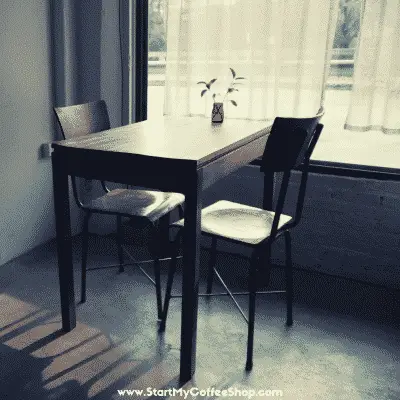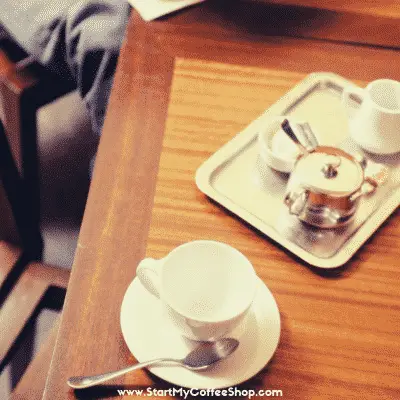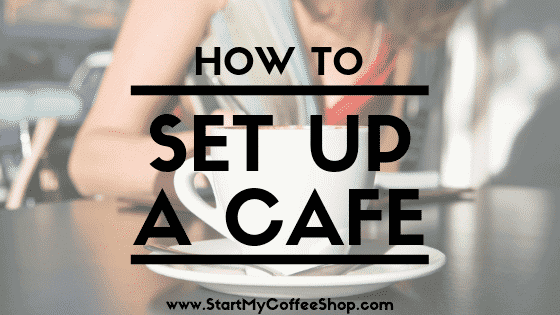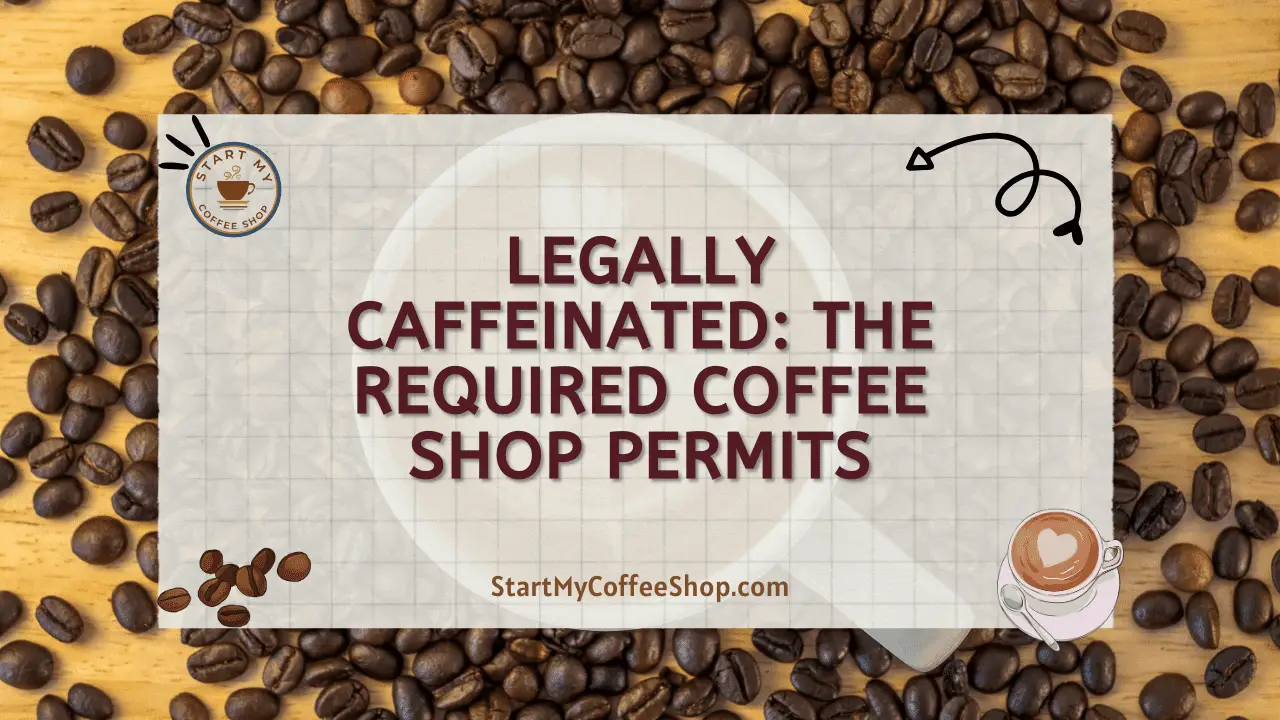Written by Kristen Pizzo
So you’re ready to take the plunge into entrepreneurship and set up a cafe business. Starting a cafe is smart move. The market for cafes has been steadily growing largely thanks to espresso-guzzling, avocado toast-eating millennials. Sky-rocketing coffee consumption has helped bolster the growth in the cafe industry, as specialty coffee is the main pillar of the typical cafe menu. Americans aren’t cheap when it comes to their morning pick-me-up: A third of us spend more money on our caffeine habit than we do on investments. The popularity of cafes isn’t just about the coffee and light bites they offer. Cafes have become a hub for the ever-growing remote or “digital nomad” workforce. Millennials are always scoping out the next best cozy, Instagrammable space where they can set up a laptop, sip a latte, and get down to business.

But how do you set up a cafe business that will become the new neighborhood favorite? Here are the steps to setting up a cafe business:
- First, you have to develop your concept. What kinds of foods do you want to serve? Where will you source your coffee from? What vibe do you want to give off? How will you differentiate your cafe from the competition?
- Next, you must scope out a strategic location. Cafes do well in walkable areas surrounded by retail shops.
- Once you have ideas for your cafe location and some estimates of rent costs, you have to think about how you will fund your cafe. Will you take out a small business loan, apply for grants, or seek help from family and friends?
- After you have locked down some funding, you can begin to look into applying for the necessary health permits and register your business.
- While working out the paperwork, you can begin to design the layout of your cafe, order furniture and equipment, start posting job ads so that you can hire staff, and develop a marketing plan.
As you can see, there are several steps to setting up a cafe business, and no entrepreneur’s journey will look the same. While some business owners prefer to start by writing a business plan, others want to dive right in. When it comes to planning for your cafe (or any business, really), there is such a thing as over planning. For a happy medium, you might consider filling out a business model canvas to help you organize your ideas in a simplified way.
Because of the exploding market, a key part of your planning should be discovering your unique value proposition. Will you be offering extensive options for those with dietary restrictions? Perhaps you’ll be an all-vegan or all gluten-free (or both) establishment. Maybe you can position your cafe as an eco-friendly business or donate proceeds to a specific cause. Or, to cater to the growing number of remote employees, you could design your cafe to offer amenities like expansive workspace, outlets, free Wi-Fi, and the option to reserve desk space.
Once you have your basic concept mapped out, you can dive into the nitty gritty logistics. Below, we will go into detail about how to set up your cafe business.

Developing Your Menu
Once you have figured out the types of menu offerings you would like your cafe to sell, you must begin testing recipes. Invite your friends and family over for breakfast, brunch, or lunch. Seek unbiased opinions from co-workers and people you can count on to give constructive feedback. Consider where you will source your food from. Are there local farmers you can work with to get produce? A local wholesale bakery that can supply the bread? If you can market your cafe as a farm-to-table style place, you’ll win over the hipster crowd. Be sure to have vegetarian and gluten-free options so that you don’t exclude valuable customers. Study what other cafes are offering and try to be unique while still offering familiar staple dishes customers expect from cafes such as sandwiches, soups, salads, and smoothies.
Creating a Coffee Menu
The coffee landscape is quite competitive, but if you keep up with the trends, you will have a leg up on the local competition. Not having dairy-free milk alternatives is no longer an option. While almond milk is still the reigning nut milk queen, it’s important to note that oat milk is rising in popularity, with more and more coffee drinkers seeking oat milk lattes. Flat white, cortado, and cold brew are also becoming increasingly popular menu items, and not all coffee shops and cafes offer them. Add-ons, such as syrups, are also must-haves, as the average American requests at least two add-on items in their coffee order.
Consider offering a list of creative flavor combinations with unique names that customers can select to help give your cafe personality and differentiate your cafe from others that simply list the flavor selections.
The coffee menu itself will require extensive research into suppliers. The coffee beans you choose will make or break your beverages. Consider supporting local roasters by sourcing beans from them. For syrups, look to major suppliers like Le Monin and Torani. For your milk alternatives, Pacific Foods offers a line of barista-style plant-based milks.
Additionally, you may want to offer whipped cream as a topping. Artisanal coffee shops don’t usually offer it, but Starbucks-regulars will expect it on certain drinks like specialty lattes. The California-based chain Peet’s Coffee has even gone the extra mile and began offering non-dairy coconut whipped cream, so if you want to stand out, you may want to consider doing the same.
The standard sizes of coffee drinks are usually 12 oz, 16 oz, and 24 oz, in some cases (a few shops also offer 32 oz drinks). However, you can keep it simple and stick to 12 oz and 16 oz options.
When pricing your coffee drinks, keep in mind that the average latte costs $4.16, and most coffee shops usually charge at least 50 cents for dairy alternatives. Iced drinks typically cost more than hot drinks. You may also want to charge extra for each flavor shot.

Picking a Strategic Location
Sites like Loopnet, 42Floors, and CityFeet can help you find available restaurant spaces to rent or lease in your city. Average restaurant rent costs are around $5,000 a month. However, cafes do not require as much space as most other restaurants, so you can probably safely expect to pay less than that. Ideal locations will be surrounded by non-competing businesses like retail stores and in attractive areas rather than strip malls that are off the beaten path.
Securing Funding
There are a myriad of ways to fund your cafe business: grants, generous family member contributions, your own savings, crowdfunding, and occasionally, investors; however, most only want to work with entrepreneurs who plan to start a chain. If you are already testing your cafe menu recipes and have the opportunity to rent a commercial kitchen, you may consider starting a small-scale catering business to help fund your brick-and-mortar cafe. That way, you will already have a loyal customer base when you open your cafe.
Indiegogo and Kickstarter are popular crowdfunding platforms for new businesses of all types, but FoodStart is a restaurant-specific crowdfunding site. When you raise money through crowdfunding, you will be expected to offer rewards of some kind to your supporters. Possible options are coupons, exclusive access to a soft opening, a first-coffee-drink-free card, and swag like mugs or tumblers with your cafe logo.
Layout/Aesthetic
Sometimes the popularity of a cafe depends highly on its Instgrammability. As a new cafe owner, you cannot afford to have a bland or unappealing space. Come up with an aesthetic theme, seek professional design help if necessary, and make your cafe a place everyone wants to feature on their feed. Curate art from local artists so that your space is unique. Put thought into every aspect; the lighting, furniture, wall colors, menu display, and even the music you choose to play are all important when it comes to designing an experience for your customers. For inspiration, look to Pinterest. Start a board to keep your ideas organized. Look to sites like WayFair, which offers business discounts on furniture. Get feedback on your interior design from tasteful people whose opinions you trust.
Hiring
Once you have an opening date in mind, begin searching for employees by posting job ads to sites like Indeed Nosh.com, and goodfoodjobs.com. If your baristas are not coming into your cafe with experience, you can outsource training if necessary using companies like Bellisimo Coffee Advisors.
Marketing Plan
Now that everything is set up, you’ll need to make sure you’ll have customers. Begin creating and posting to social media accounts well before the grand opening. Reach out to local news outlets by sending press releases about your opening. Get in touch with local food bloggers and offer free food and coffee in exchange for them coming in and covering your cafe with a photoshoot and blog post before the opening date. To build a following, find the most popular local food spots in your area and “like” photos people have posted of those places. Engage with local foodies who post about similar establishments to try to generate interest in your cafe. If you cannot personally dedicate adequate time to social media marketing, consider hiring a freelancer on Upwork to help you manage your cafe’s online presence. While it is an added expense, in 2019 you cannot afford to not have a strong social media presence. Many of your potential customers will find you through photos posted on Instagram.
You’ll also need to hire a website developer to create your cafe website. It will need to include basic information such as your menu and location, and it must be optimized to show up towards the top of the Google search results list when potential customers are looking for cafes in your local area. You can help improve website traffic by also starting a blog, where you can post about your menu offerings, your “how we started” story, any events such as open mics that you might host, and you can even spotlight regular customers with profiles listing their go-to menu items to help create the sense that your cafe is a place where the local community comes together.
On top of a Facebook and Instagram account, you should also create a Google My Business and Yelp page. You will need to have someone dedicated to responding to reviews on Yelp to help maintain your cafe’s image and establish a good relationship with your customers.
You can also consider including community donations as a part of your marketing mix. Make it known on your website that you can offer in-kind or gift card donations to local schools and nonprofits. Donating is good PR and a cheap form of marketing.
Extra Touches
- With more and more consumers, cities and businesses rejecting plastic straws, it’s important to have the environment in mind when sourcing supplies for your cafe. Consider Hay straws and biodegradable plastic cups, cutlery, and to-go boxes, and use reusable dishware when possible. Ask customers “For here or to-go?” even if they are just ordering coffee, so that you can save plastic cups whenever possible. Offer customers incentives for bringing reusable coffee cups. For example, Starbucks offers a 10-cent discount, but you could offer points towards free coffee by using a punch card system or other rewards programs like FiveStar.
- Consider partnering with a local food pantry or soup kitchen to be sure no leftovers are ever wasted. You can also use apps like OLIO to find takers for leftover food.
- More and more cafes are branding themselves as dog-friendly, so allowing four-legged friends in your establishment is definitely something you may want to consider.
- Establish your cafe as a community gathering place by hosting open mic nights for local musicians, poets, and comedians.
- Consider offering catering services. This will help get the word out about your cafe and provides an additional revenue stream.
Frequently Asked Questions
Depending on the size of your space, the number of menu items you want to offer, and where you are located, the overall startup costs for your cafe will vary greatly. However, this blog offers a helpful chart of cost estimates, listing everything from average espresso machine costs to average employees salaries. The overall cost estimates are between $60,000 and $200,000. That’s a huge range, but once you have a clear idea of your cafe concept, you should be able to come up with an informed, accurate estimate.
The Small Business Administration offers a helpful guide to registering your cafe business. Along with registering your cafe, you will also need various permits. Contact your local health department to begin the process. For a comprehensive guide to all of the permits and licenses you will need, read this blog.
Setting up a cafe business takes time, careful planning, and yes, a lot of money. But if you really believe in your cafe concept and are confident that you can offer unique, quality food and beverages in an appealing atmosphere, you can bring your cafe business dream to life.
To learn more on how to start your own coffee shop checkout my startup documents here
Please note: This blog post is for educational purposes only and does not constitute legal advice. Please consult a legal expert to address your specific needs.

Hi! I’m Shawn Chun
My adventure in coffee began when I first launched my first coffee shop back in the early 2000s. I had to figure out so many things on my own and to make it worse within 2 years of opening two large corporate coffee chains moved in just blocks away from me!
As I saw smaller and even some larger coffee shops in the neighborhood slowly lose customers to these giant coffee chains and slowly close up shop, I knew that I had to start getting creative…or go out of business.
I (like you may be) knew the coffee industry well. I could make the best latte art around and the foam on my caps was the fluffiest you have ever seen. I even had the best state-of-the-art 2 group digital Nuova Simonelli machine money could buy. But I knew that these things alone would not be enough to lure customers away from the name brand established coffee shops.
Eventually, through lots of trial and error as well as perseverance and creativity I did find a way to not only survive but also thrive in the coffee/espresso industry even while those corporate coffee chains stayed put. During those years I learned to adapt and always faced new challenges. It was not always easy, however, in the end, I was the sole survivor independent coffee shop within a 10-mile radius of my location. Just two corporate coffee chains and I were left after that year. All told the corporate coffee chains took down over 15 small independent coffee shops and kiosks and I was the last one standing and thriving.
Along the years I meet others with the same passion for coffee and I quickly learned that it is not only “how good a barista is” that makes a coffee shop successful, but the business side of coffee as well.
Hence why I started this website you are on now. To provide the tools and resources for up and coming coffee shop owners to gain that vital insight and knowledge on how to start a coffee shop successfully.
Stick around, browse through my helpful blog and resources and enjoy your stay! With lots of LATTE LOVE!
Shawn








